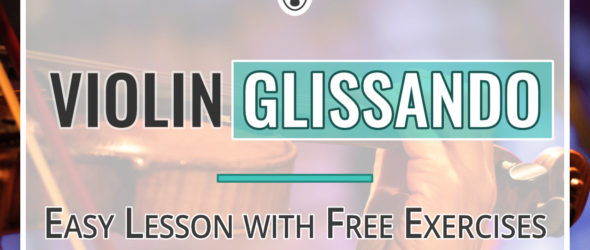The violin glissando is a fun technique that pops up in many genres of music we play. It’s essentially a slide from one note to the next and is used as an expressive technique.
This easy violin lesson will help you understand what the glissando is and how exactly to play it. Be sure to download the helpful exercises in this article to practice this technique for yourself!
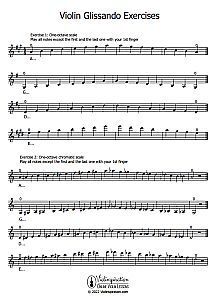
Free Violin Glissando Exercises
What is Glissando?
Glissando is an expressive ornament where the performer slides from one pitch to another. The term is borrowed from the Italian word glissando, and derives from the French word glissez, which means “to slide.” Glissandi (plural for glissando) can happen on notes that ascend or notes that descend.
You may see the term written as “gliss”–this is just an abbreviation of the full word. You might hear people say “gliss” or “slide” interchangeably to mean the same musical technique.
Sliding from one pitch to another is as old as string instruments themselves, but the glissando as we know it on the violin was made popular by late Romantic composers.
What is Glissando on the Violin?
On violin, the gliss technique is sliding from one pitch to another with the same finger. Violinists usually perform an entire glissando on one string, but some glissandi are so big they span different strings.
The technique is used more in today’s classical music than in older classical music, so all modern players learn how to play glissando on the violin.
A gliss sounds fun, and it can be used to evoke different sound effects and moods.
What is Chromatic Glissando on the Violin?
A chromatic glissando is sliding from one pitch to the other with very short stops on each semitone.
Examples of Glissando in Violin Repertoire
The glissando technique is used often in solo violin music but is less popular in orchestra music where many instruments are playing together at the same time. Glissando is usually seen as a flashy soloist technique to impress an audience.
When glissandi are used in orchestral music, it’s typically by current composers looking to create sound effects. You might recognize the slow gliss sound from scary moments in movies: the glissandi produce suspense and tension!
A great example of a chromatic gliss on the violin is Carmen Fantasy by Pablo Sarasate. Here’s a great recording of violinist Julia Fischer performing the solo.
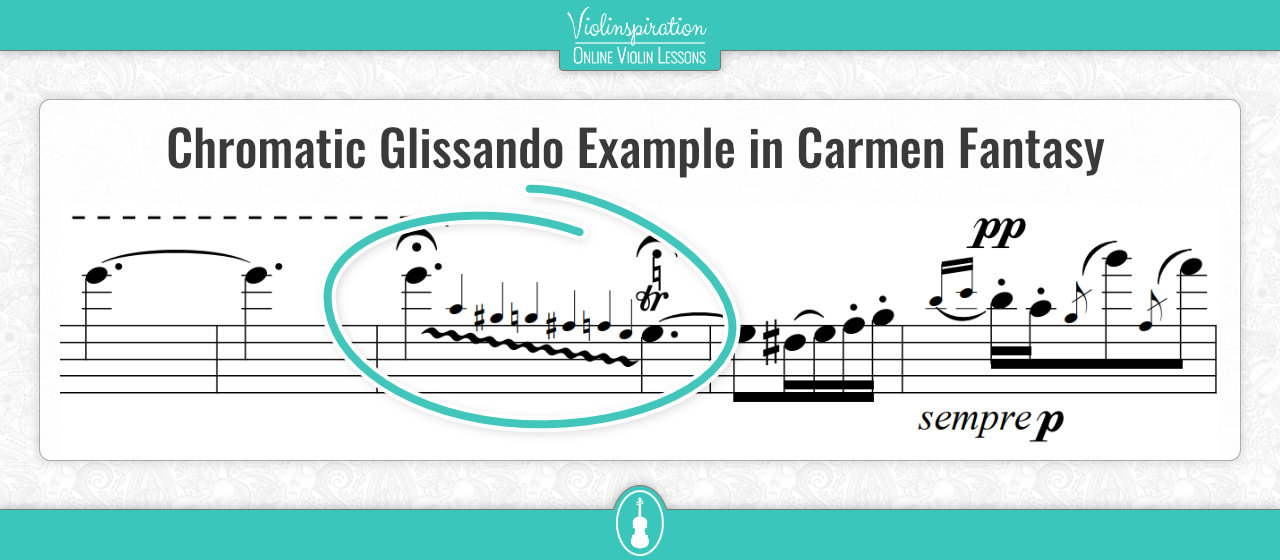
Another example of a gliss or slide is in Oberek by Grażyna Bacewicz. Listen carefully to the following recording at 1:28.
Slides also show up in other genres like Irish music. The slides you’ll play there are a bit different from the glissando in this article, but if you like to learn more about them, I have an easy guide to ornamentation in Irish music that should answer all your questions.
Slides in other genres of music can create a fun, almost silly touch. It sounds almost like singing or laughing!
Glissando in Violin Sheet Music Notation

There are three ways we usually see glissandi written out in our music. The first is a thick black bar between two notes.
The second option is a squiggly line between two notes.
And the third notation is a plain line between two notes, with or without the label “gliss.”
Some composers will use multiple versions of these notations in one piece of music. If this happens, they’ll probably include some directions about how they’d like each gliss performed.
How do I play Glissando on the Violin?
Prerequisites
To play a gliss on the violin, you’ll want to already have a strong left-hand technique. I have a basic guide on holding the violin with the left hand. Be sure you’re comfortable with everything in that article before you try to play glissandi! Keeping your left hand in shape will help the whole passage stay in tune.
You’ll also need some experience in shifting positions before trying this technique. Playing a glissando is a very similar feeling to shifting, except we want the notes in between our start and destination to be audible. This means someone listening could pick out the individual notes in the slide. If you’re not familiar with shifting yet, check out my beginner’s guide!
Left Hand Glissando Technique
While you slide up or down the glissando, it can be helpful to keep a vibrato feeling in your left hand. Vibrato tends to help us feel loose and eases tension. We don’t want to squeeze the neck of the violin during our glissandi, because it’ll create a rough, bumpy sound.
Begin on the starting note of the glissando, and create an equal slide between it and your destination note. We shouldn’t create any harsh accents during the slide; the point of this technique is an even sound between endpoints. For some expression, you can emphasize the end of the slide into the destination note.
Composers will sometimes write a note about how they’d like a gliss performed. Different music requires different sounds, especially depending on the composer’s nationality and style.
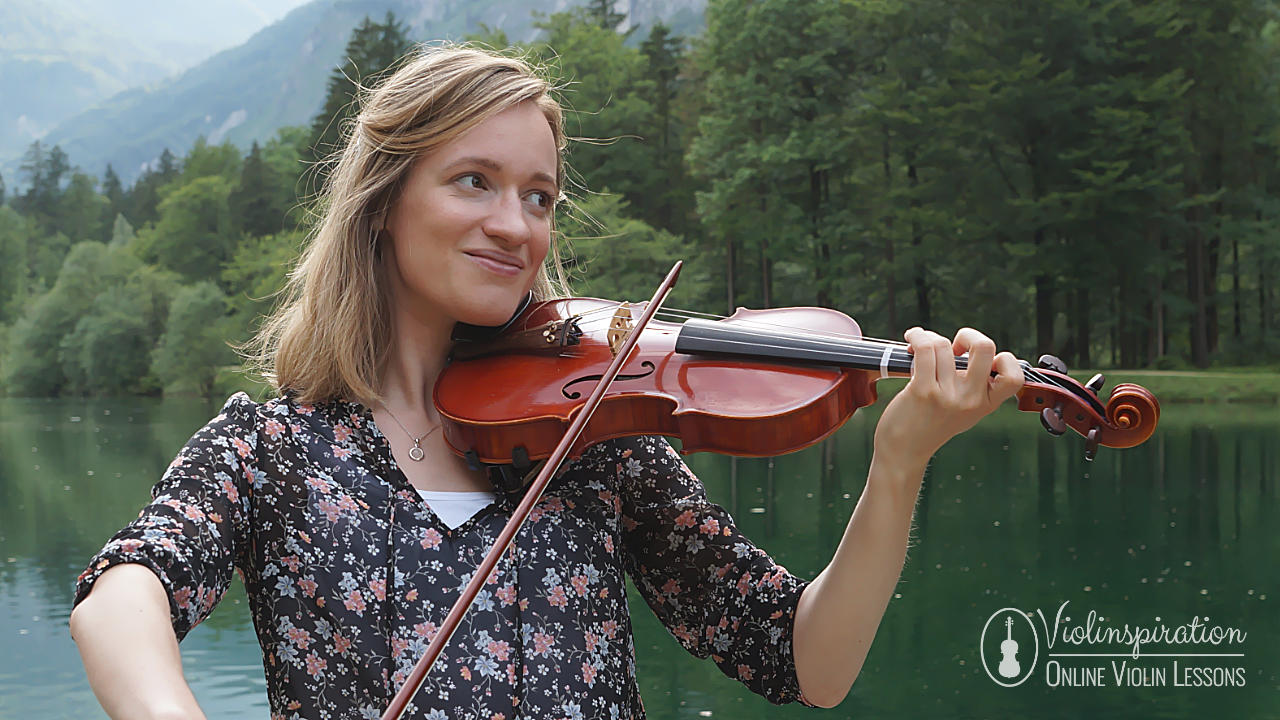
Bowing Technique
Don’t let your bowing technique fall behind during the glissando. Instead, actually focus on keeping a smooth bowing motion, and your left hand will continue sliding smoothly. You need smoothness to come from both left and right hands to create the rich, even sound we want to hear in the glissando. If either hand feels “bumpy,” that’s exactly what we’ll end up hearing.
In addition to your left and right arms working together, be sure to let your left arm move as well. Don’t leave your thumb or the rest of your arm behind while you slide up or down the neck! You’ll hear a much smoother result if your left hand and arm move together as one unit.
Glissando Timing
The slide should take up space evenly between the starting note and the destination note. You want the sliding movement to be at the same tempo as the music and the same speed as your bow. If your left hand shoots up or down super fast, it’ll sound jarring in the music.
Sometimes you’ll want to make the glissando a little slower than the tempo and the bow speed for extra expression, and that’s okay. You might see other tempo directions in your sheet music during the glissando–be sure to follow the composer’s instructions!
Glissando Exercises for Violin
Before playing glissandi in difficult violin music, it’s a great idea to practice the technique on its own to form muscle memory. Here are a few exercises for you to try first.

Free Violin Glissando Exercises
One octave scales with one finger on one string
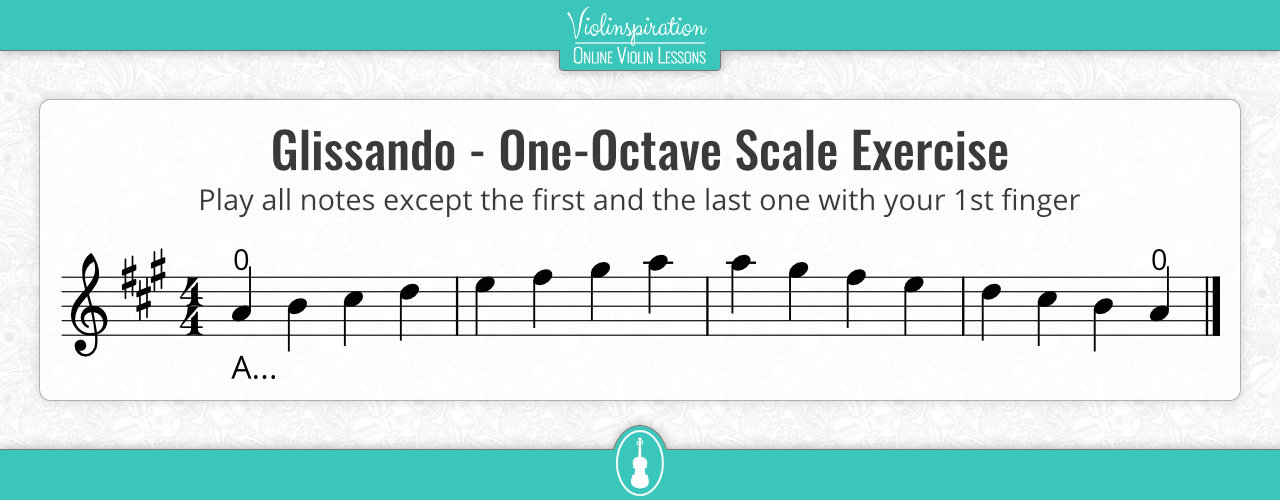
Practicing a major scale all on one finger on the same string will help you map out the fingerboard and understand where each pitch is located. This is a great way to start working on the glissando sound if you already know what a major scale should sound like.
One octave chromatic scale with one finger on one string
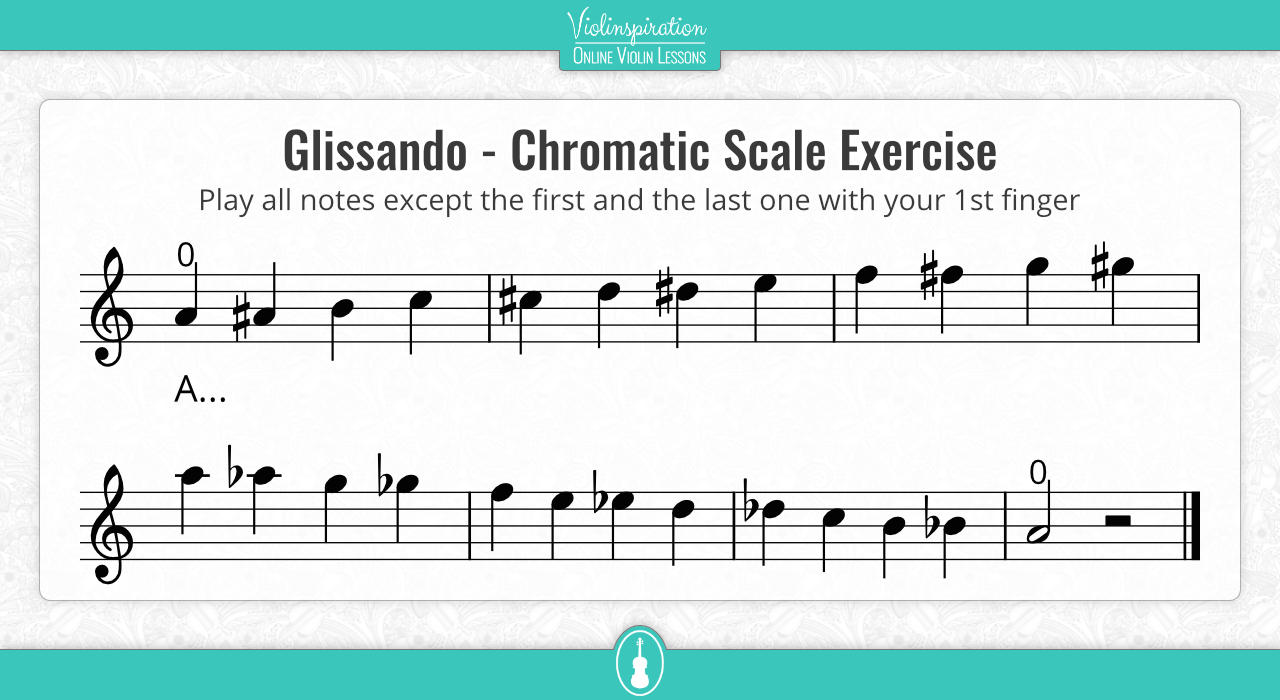
Practicing a chromatic scale the same way will go even further and help you map out the fingerboard in more detail.
Slides from first to the third position
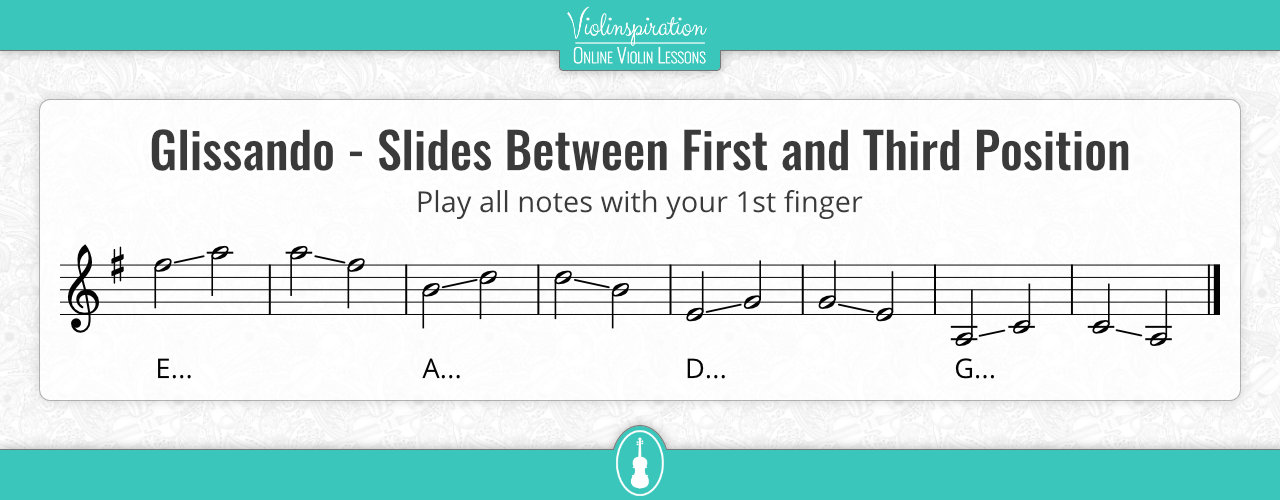
After preparing your fingers and the left arm to reach higher notes, practice slides starting in the first position and ending in the third position. Try to do the slide with each finger on each string, always using your first finger as an anchor.
After that, you can try to slide even further up the fingerboard!
Practice the glissando exercises with a metronome to learn the timing and to learn how to plan the speed of your glissando based on the tempo of a piece.
FAQ
What is the difference between portamento and glissando?
It’s very common to be confused between glissando and portamento–they both include sliding. A portamento “carries” one note to another. This is more subtle than a glissando; it’s more like an audible shift.
Portamento vs glissando – length
In a glissando, we can hear individual notes within the slide. A portamento is shorter and less intentional. A glissando can take up a long amount of time, depending on the context and how it’s written in the music.
Portamento vs glissando – the way of playing
A glissando should start as soon as we play the first note, and the slide should be equal through the entire journey to the destination note. A portamento generally starts later, just before the destination note. It doesn’t need to be an evenly paced slide.
A portamento is more of an expressive ornament added by the violinist. It doesn’t really connect the first and last notes evenly like a glissando does; instead, it’s a small slide from one note to the next. It’s usually considered bad taste to use many portamentos in one passage, so it’s generally used sparingly.
Portamento vs glissando – listening example
Schubert’s first Violin Sonata includes shifts that happen under one slur. We can assume these shifts will be portamentos. You can hear these small slides at the beginning of this recording:
Portamento vs glissando – sheet music notation
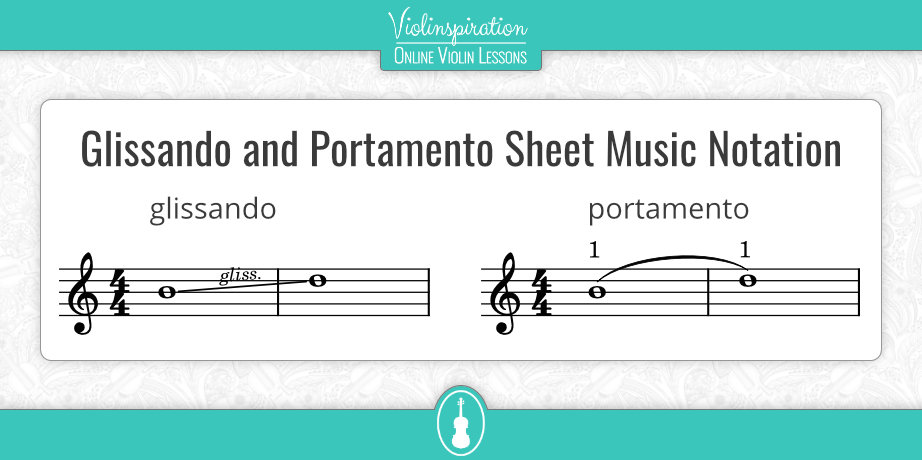
Glissando are usually notated with a line, whether thick, thin, or wavy. Portamento is not always notated. It’s more up to the performer than it is to the composer. However, you may see a fingering that can suggest a portamento. This would be a shift on the same string under one slur. Since you’d shift in the middle of a bow stroke, the shift will be audible.
Which Instruments Use Glissando?
Most instruments, including the human voice, can use glissandi in their technique! Only a few instruments can’t slide, like unpitched percussion and the oboe.
String Instruments
All unfretted stringed instruments, including violin, viola, cello, and double bass can perform a glissando. Harp players can also play glissandi by running their fingers along all the strings in between two pitches.
The guitar, even though it’s a fretted instrument, can also slide. The performer slides their finger from the starting note to the destination note, evenly, similar to the way we play a slide on the violin.
Brass Instruments
Brass instruments also use this technique often. You’ve probably heard a trombone slide before. It’s so fun!
Wind Instruments
Woodwind instruments can play glissandi too, but they need to move their fingers quickly, and it’s more difficult than on brass or string instruments.
A very famous woodwind glissando is played by the clarinet at the beginning of George Gershwin’s famous piece for orchestra, Rhapsody in Blue. Here’s a great recording to listen to:
Piano and Percussion
Glissandi can also be played on the piano. The musician runs their hand over all the keys in between two notes to create the effect.
Pitched percussion can also play glissando. Pitched percussion instruments include the marimba, xylophone, and vibraphone. On these instruments, the player runs their mallet along the keys. On a timpani, the percussionist uses a tuning pedal with their foot to create the glissando sound.
Conclusion
The glissando is a fun technique to try on the violin, and we can find it in all genres of music! Once you know what to listen for, you’ll probably hear glissandi all over the place.
I hope this guide helped you understand what this technique is, and how to play it on your violin. Make sure to download the booklet with exercises, print it, and put it on your music stand to quickly learn this technique.

Free Violin Glissando Exercises
